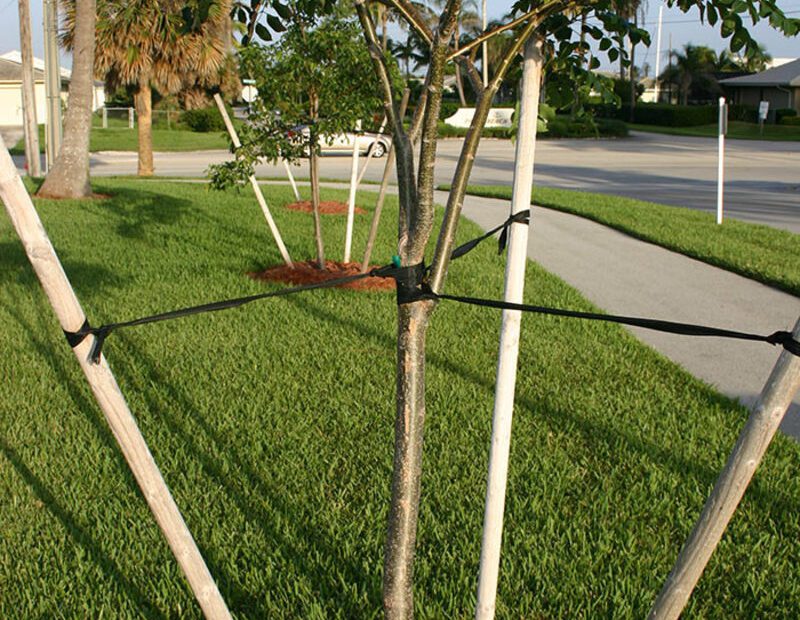When Mother Nature playfully paints the world with hues of emerald, scarlet, and amber, our eyes dance with delight. The vibrant foliage adorning the trees transforms our surroundings into a living canvas, enchanting us with its breathtaking beauty. But amidst this spellbinding spectacle, there exists a silent companion, overlooked yet crucial: the humble stake. These ancient sentinels, known for their unwavering support, guide the growth of young trees. However, as the tree matures, a time eventually arrives when it yearns to stand tall, unaided, and fully embrace the world on its own. In this article, we embark on a journey to unveil the mystique of when to remove stakes from trees, allowing our arboreal friends to claim their rightful place in the grand tapestry of nature.
1. Understanding the Purpose and Role of Tree Stakes: Best Practices for Proper Tree Support
When to Remove Stakes From Trees
Tree stakes play an essential role in supporting young trees and ensuring their stability during the early stages of growth. However, knowing when to remove these stakes is just as crucial as using them in the first place. While it may be tempting to leave them in place indefinitely, keeping tree stakes on for too long can do more harm than good. Here are some best practices and guidelines to consider when deciding the right time to remove stakes from your trees.
1. Evaluate tree stability: Before removing tree stakes, it’s important to assess the tree’s stability. Ensure the trunk is strong enough to support itself without the stakes. Observe how the tree sways in the wind and check for any signs of movement that could indicate the need for continued support.
2. Age of the tree: Generally, most young trees need support for the first one to two years after planting. However, the exact duration may vary depending on the tree species and its growth rate. Research the specific requirements of your tree to determine the appropriate timeframe for stake removal.
| Features | Tips |
|---|---|
| 1. Flexible stakes | Use stakes that allow some movement for the tree, promoting trunk strength development. |
| 2. Loosened ties | Gradually loosen ties to encourage the tree to strengthen and grow thicker bark. |
| 3. Remove gradually | Take out one stake at a time over the course of several weeks or months to ensure the tree’s stability. |
2. Indicators of Tree Stability: How to Determine When to Remove Stakes
Staking young trees is a common practice to provide support and ensure their stability during the critical early years of growth. However, it is crucial to know when it’s the right time to remove the stakes. Leaving the stakes in place for too long can hinder the development of a tree’s root system and even lead to potential harm. Here are a few indicators to help you determine when to bid farewell to those supportive stakes:
- Root anchoring: Observe if the tree’s roots have established a firm grip in the surrounding soil. Gently tug on a lower branch to check if the tree stands firmly on its own. If the root system remains strong even without the stakes, it’s a sign that removal may be appropriate.
- Trunk flexibility: Assess the flexibility of the tree’s trunk. When it sways smoothly in the wind without leaning excessively, it indicates that the trunk has developed enough strength to support itself, indicating the need for stake removal.
- Branch development: Take note of the tree’s branches. If they are growing strong, spreading out and forming a balanced canopy, it suggests that the tree is developing in a healthy manner. This development is a positive sign to consider stake removal.
| Feature | Tip |
| Rod movement | If the staking rods move easily when touched, it may indicate that the tree has developed enough stability and the stakes can be removed. |
| Bark protection | Remove any bark protectors as soon as the tree has grown enough to avoid damage from pests or diseases caused by trapped moisture. |
| Guidewire tension | Loosen the tension on any guide wires to allow the tree to move naturally and strengthen its trunk. |
Remember, keeping stakes in place for an extended period can impede a tree’s natural development. Regularly assess your tree’s stability using these indicators and promptly remove stakes when appropriate. By doing so, you allow the tree to grow strong and thrive on its own, becoming a picturesque addition to your landscape.
3. A Step-by-Step Guide: Safe and Timely Removal of Stakes to Promote Natural Growth
When it comes to the well-being of our beloved trees, knowing when to remove stakes is crucial. Although staking is often necessary to support young and fragile saplings, leaving them in place for too long can hinder their natural growth and development. In this guide, we will walk you through the step-by-step process of safely and timely removing stakes, ensuring that your trees thrive in their natural environment.
Here are some key features and tips to keep in mind:
| Benefits | |
|---|---|
| Assess tree stability | Ensures the tree can stand independently and promotes natural trunk and root growth. |
| Consider weather conditions | Choosing the right time to remove stakes minimizes the risk of damage from strong winds or storms. |
| Gradually reduce support | Allows the tree to acclimate and develop strength to support itself effectively. |
With these steps and considerations in mind, you can ensure a safe and timely removal of stakes, enabling your trees to grow and flourish naturally. Remember, each tree is unique, so observing their growth and assessing their stability regularly will help determine when it’s the right time to bid farewell to those supporting stakes!
4. Ensuring Long-Term Tree Health: Post-Stake Removal Care and Maintenance Tips
Properly supporting young trees with stakes is crucial for their development. However, knowing when to remove the stakes is equally important. Over time, stakes can actually hinder a tree’s growth if left in place for too long. Here are some key tips for ensuring long-term tree health and knowing when to say goodbye to those stakes!
splay: flex;flex-wrap: wrap">Stake Removal Timing:
- Monitor the tree’s stability by gently pushing it. If it can stand upright on its own without wobbling, it might be time to remove the stakes.
- Consider the tree’s growth rate and resilience to wind. Generally, stakes can be removed after the first year of planting when the tree has developed a sturdy root system.
- Remove stakes gradually by loosening the ties first. This way, the tree can adjust to the changing conditions and strengthen its trunk.
Post-Stake Removal Care:
- Inspect the tree for any circling or competing roots. If detected, gently prune or redirect them to encourage healthy growth.
- Apply a layer of mulch around the base of the tree to improve moisture retention and prevent weed competition.
- Regularly water the tree during dry spells, especially in its first few years, to ensure it receives adequate hydration.




